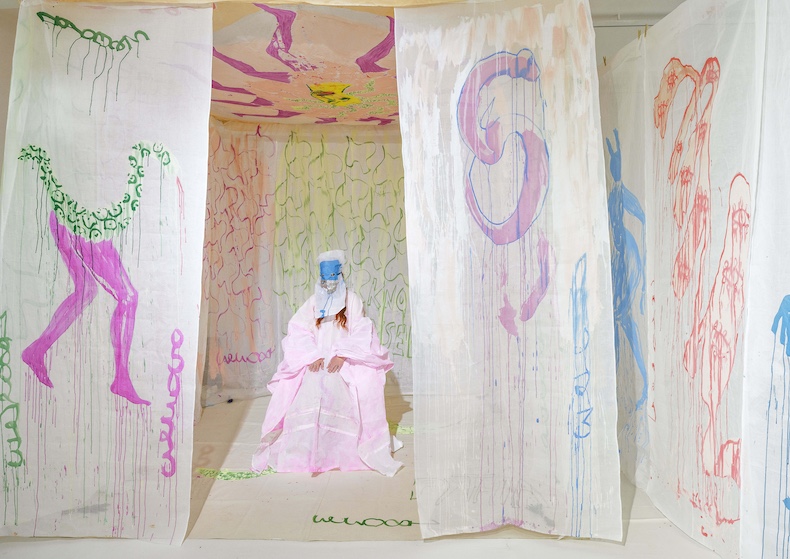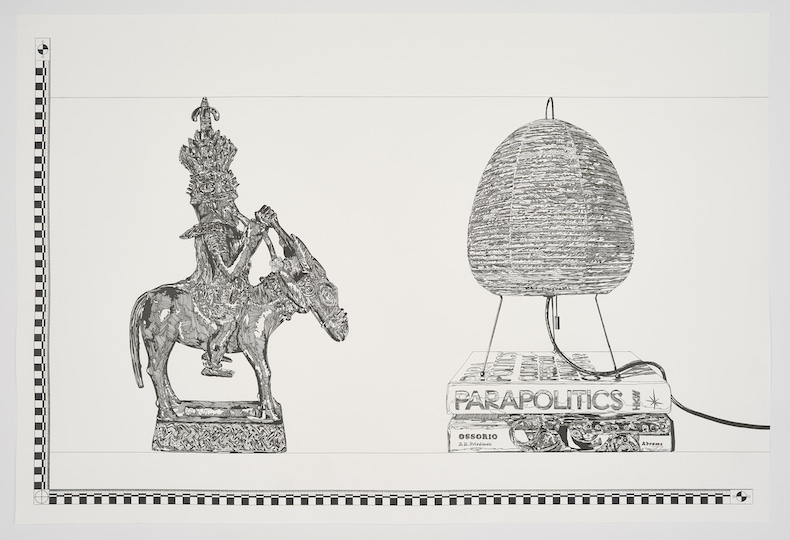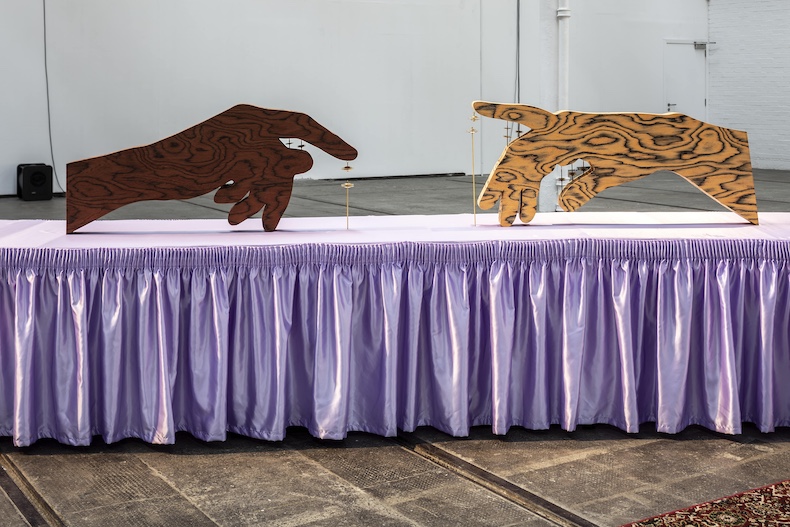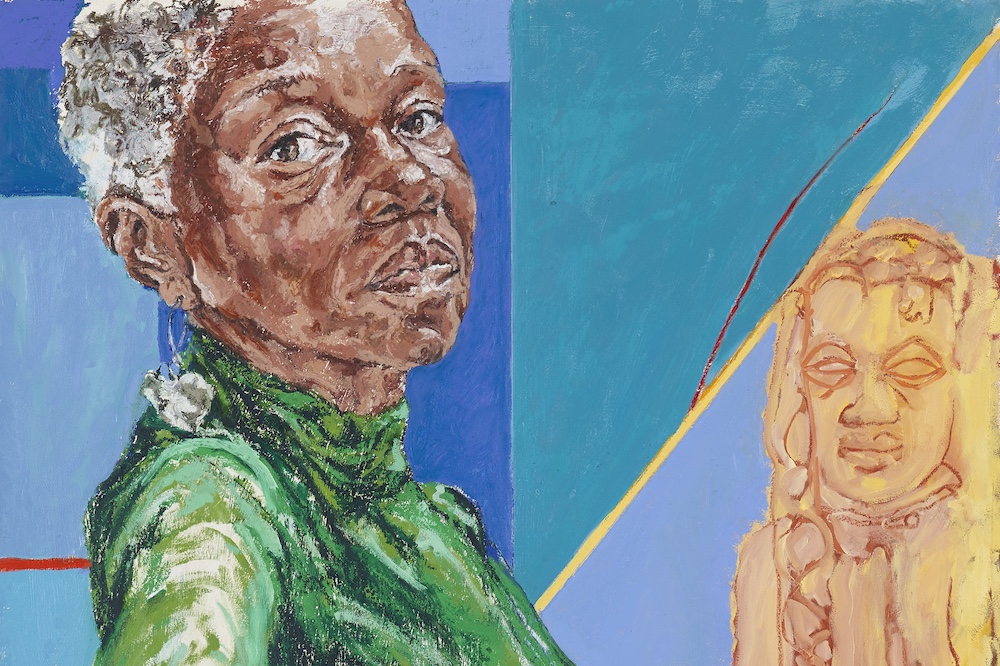You can tell a lot about an artist from the roll call of their acknowledgements. At Tate Britain, just outside the entrance to the Turner Prize 2024 exhibition, four large posters are stuck to the wall with biographies of the four nominees. Each one ends with a list of thank yous. Claudette Johnson names fellow artists, former comrades from the days of the British Black Arts Movement such as Lubaina Himid and Trevor Mathison. Jasleen Kaur thanks her collaborators, the people who worked on the show, including the fabricators, the sound editors and her vocal coach, Ustad Baljit Singh. Most of Pio Abad’s list is taken up by curators and critics, such as Faye Belsey from the Pitt Rivers Museum and Marian Pastor Roces. Delaine Le Bas’s first acknowledgement, by contrast, is to her grandmother, who died in 2022 while Le Bas was preparing the show at the Vienna Secession for which she has been nominated.
All four exhibitions in this year’s exhibition are self-portraits of a sort. It is, all round, a deeply personal Turner Prize. Biographical details mingle freely and intimately with broader geopolitical concerns. Nowhere more so than in Le Bas’s space, in which traces of the artist’s body are everywhere. The calico and organdie fabrics that hang throughout were hand-painted by the artist in situ and bear the very visible marks of her gestures in their loose, carefree brushstrokes with long strips of paint dripping from every figure. We see harlequin-like characters, angels, dollar signs, exposed organs and skulls all crudely and energetically splashed on to every visible surface. The artist’s footprints run along the floor in one area. Elsewhere the ground is covered in canvas and scattered with Pollock-like splatter. Le Bas hopes that over time the canvas floor will record the footprints of the show’s visitors, slowly accumulating further marks as the show progresses. It’s a wild and deliberately cacophonous show, housed within a custom architecture of hanging drapes and silvered false walls that ironically mirrors the grandiose setting of the Tate itself.
Installation view of Delaine Le Bas, ‘Incipit Vita Nova. Here Begins The New Life/A New Life Is Beginning’ at the Vienna Secession in 2023. Photo: © Iris Ranzinger; courtesy Vienna Secession; © Delaine Le Bas

None of the other nominees for this year’s prize have responded so directly to the venue. Abad’s very wordy and rather worthy display has been transposed from its original location at the Ashmolean Museum in Oxford. There it dealt unswervingly with the site of its exhibition, taking collection items such as the deer-hide robe of the 16th- and 17th-century Native American chief Powhatan – here recreated as a large drawing (about two metres by three) in red coloured pencil, resembling the map of some wild, uncultivated territory – or a collection of Mindanao swords held by the Pitt Rivers down the road. Repurposed and recontextualised by Abad, these became a pointed critique of the practices of a Western museum still mired in controversy over colonial-era acquisitions. But does it lose some of its sting in being further transported from the place it was critiquing to a different gallery altogether? I can’t help but wonder what an Abad show that explicitly addressed the Tate’s own (acknowledged) colonial history might look like.
1897.76.36.18.6 (2023), Pio Abad. Courtesy and © Pio Abad

Jasleen Kaur’s space recreates her show at Tramway in Glasgow from last year. There it occupied a large rectangular post-industrial space; here it’s been cramped into a dogleg room with blond parquet flooring. But I’m not sure that matters. The show deftly composes a vast array of quite specific references to Kaur’s own Scottish-Indian upbringing – some real (half-drunk bottles of Irn-Bru, a CD of Nusrat Fateh Ali Kahn, her dad’s old Ford Escort) and some fabricated (a purple football scarf with the word LONGING stretched out across its length, a bright orange shell suit with ‘Can’t Do It’ running down the leg in place of Nike’s more positive slogan). Meanwhile, a soundtrack plays out across the room: in one corner a motorised harmonium plays a steady F natural in a breathy drone; across the room, a set of six giant wooden hands hold finger cymbals which occasionally tinkle of their own accord; we hear Kaur and her vocal coach practising Sufi devotional music; and from the car stereo we hear N-Trance, ‘Rapper’s Delight’ and Panjabi MC. It’s a carefully put together space that warmly invites viewers to linger a while, maybe lie down on the big fake Axminster rug and gaze up at a photo of the sky over Pollokshields on a semi-transparent screen suspended from the ceiling and scattered with detritus. It makes for a polluted sort of idyll, but an idyll nonetheless.
Installation view of Jasleen Kaur, ‘Alter Altar’ at Tramway, Glasgow in 2023. Photo: Keith Hunter; © Jasleen Kaur

In comparison to the profusion of stuff in the other rooms, Claudette Johnson’s exhibition looks positively austere. There’s maybe just a dozen paintings and pastel sketches hanging with about half that again in a vitrine at one end of the room. Apart from that, the walls are left a pale cream colour. There’s something confident in that. Johnson is surely one of the UK’s greatest living painters. Her work combines a deftly seductive draughtsmanship with a conceptual programme concerned with centring Black bodies so long left out of Western art history, and an evident, palpable love of the human form, its flesh and its flaws. Her images always have a sharp emotional tug – never more so than in the double portrait of the artist’s sons, Friends in Green + Red on Yellow (2023), a picture of great warmth, included here after showing at Johnson’s exhibition at Ortuzar Projects in New York last year.
Johnson has been nominated both for that show and for an exhibition at the Courtauld, which took place late last year. Works from both appear here alongside a small number of brand new paintings, the biggest and most breathtaking of which is her Pietà (2024). Modelled loosely on Bellini’s late work the Martinengo Pietà at the Accademia in Venice, Johnson’s work – pastel and oils on a loose back cloth with crinkled edges – seems to be bursting out of the wall on which it hangs. The image of a Black mother cradling her son’s body is framed by the words of an Instagram post seen by Johnson following the death of George Floyd: ‘Every mother was called when he called for his mother.’ The work is hung immediately behind the portrait of Johnson’s own sons.
Protection (2024), Claudette Johnson. Photo: Andy Keate; courtesy Hollybush Gardens, London; © Claudette Johnson

There’s a great deal of mourning in this year’s Turner Prize show, from Abad laying out a giant reproduction of one of Imelda Marcos’s necklaces in concrete, like a tombstone, to the funeral flowers spelling VERA suspended in Kaur’s Glasgow sky, and the ghost of Le Bas’s Nan and the many memento mori scattered throughout her space. None hit me in the gut quite like Johnson’s Pietà. Hers is the kind of show you would put together if you were past caring about the belated approval of an art establishment that had long neglected your talent. I’ve been going along to the Turner Prize exhibition for a few years now and I’ve definitely seen galleries that looked kind of like Pio Abad’s room here and a fair bit like Jasleen Kaur’s room and pretty much like Delaine Le Bas’s, too. But I’m not sure if, in recent years, I have seen a Turner Prize show that looked quite like Johnson’s. Could it be that in the 40th anniversary of a prize that gave us an unmade bed, a bisected cow and a light turning on and off, the most radical exhibition of contemporary British art consists of a series of appealing, well-executed, recognisably figurative painted portraits?
The 2024 Turner Prize is at Tate Britain, London, until 16 Feburary 2025.



